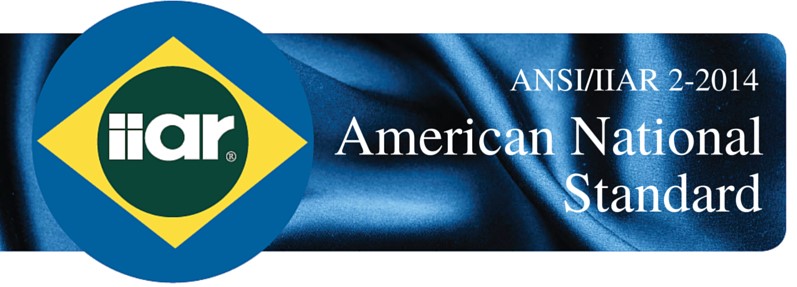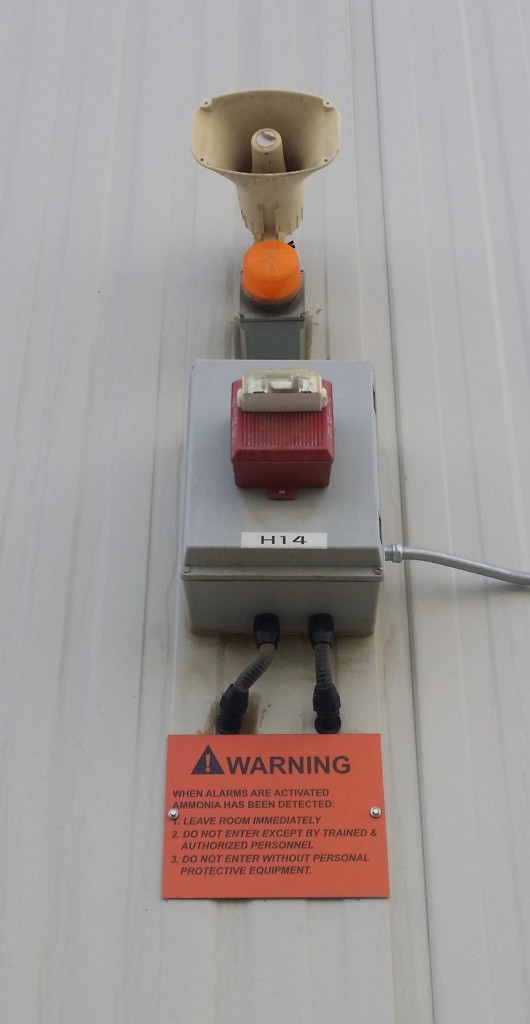Ammonia Detection Requirements

The recent release of ANSI/IIAR 2-2014 has provided the ammonia refrigeration industry with much needed direction on the topic of ammonia detection in a refrigerated facility. Prior to the release of this document, IIAR 2 only addressed ammonia detection within the context of a machinery room and left the requirements of “other than machinery rooms” to ASHRAE 15 and other model codes (refer to the blog that we wrote in May 2015 for more information). IIAR believed this topic was important enough to assign a whole chapter (Chapter 17) to its requirements. The following is a summary of the new requirements:
Alarm Levels
ANSI/IIAR 2-2014 §17.7 outlines three (3) distinct alarm levels: Level 1, Level 2, and Level 3. These levels build on each other as follows:
Level 1 Detection [ANSI/IIAR 2-2014 §17.7.1]
Level 1 ammonia detection must have the following features:
- At least one ammonia detector shall be provided in the room or area.
- The detector shall activate an alarm that reports to a monitored location so that corrective action can be taken at an indicated concentration of 25 ppm or higher.
Level 2 Detection [ANSI/IIAR 2-2014 §17.7.2]
Level 2 ammonia detection must include all Level 1 requirements and also the following feature:
- Audible and visual alarms shall be provided inside the room to warn that, when the alarm has activated, access to the room is restricted to authorized personnel and emergency responders.
Level 3 Detection [ANSI/IIAR 2-2014 §17.7.3]
Level 3 ammonia detection must include all Level 2 requirements and also the following features:
- For machinery rooms, additional audible and visual alarms shall be located outside of each entrance to the machinery room.
- Upon activation of the alarm, control valves feeding liquid and hot gas to equipment in the affected area shall be closed. Refrigerant pumps, nonemergency fans, or other motors that are part of the ammonia refrigeration equipment in the room shall be de-energized.
- Upon activation of the alarm, emergency exhaust systems, where required, shall be activated.
It is worth noting that Level 2 detection is only required in §14.4 which is the section devoted to “package systems”. Therefore, a facility with a traditional “built-up” ammonia system, would only need to use Level 1 and Level 3 detection.
Areas Required
Machinery Rooms
Machinery Rooms must be equipped with a variation of Level 3 detection (Level 3 is never specifically mentioned in Chapter 6). §6.13 outlines the specific requirements for machinery room detection. Two (2) specific requirements worth highlighting include:
ANSI/IIAR 2-2014 §6.13.2.3 Detection of ammonia concentrations equal to or exceeding 150 ppm (1/2 IDLH) shall activate visual indicators and an audible alarm and shall activate emergency ventilation, where required, in accordance with Section 6.14.7. Once activated, emergency ventilation shall continue to operate until manually reset by a switch located in the machinery room.
ANSI/IIAR 2-2014 §6.13.2.4 Detection of ammonia concentrations that exceed a detector’s upper detection limit or 40,000 ppm (25% LFL), whichever is lower, shall activate visual indicators and an audible alarm and shall activate emergency ventilation, where required, in accordance with Section 6.14.7. Once activated, emergency ventilation shall continue to operate until manually reset by a switch located in the machinery room. In addition, the following equipment in the machinery room shall be automatically de-energized:
- Refrigerant compressors.
- Refrigerant pumps.
- Normally closed automatic refrigerant valves that are not part of an emergency control system.
Other than Machinery Rooms
Rooms containing ammonia that do not fit the definition of a “Machinery Room” are classified as an “Other than Machinery Room” in ANSI/IIAR 2-2014. “Other than Machinery Rooms” must be equipped with Level 1 detection (§7.2.3) unless one of the following exceptions applies:
- Unoccupied areas with continuous piping that does not include valves, valve assemblies, equipment, or equipment connections.
- Where approved, rooms or areas in industrial occupancies that are always occupied and are provided with an alternative to fixed detection and alarm equipment, such as an emergency action plan.
When “Other than Machinery Rooms” require emergency ventilation, the space must be equipped with Level 3 detection. Examples of such spaces includes equipment pits and areas containing compressors or recirculators which do not meet the definition of a “machinery room”.
Power Supply and Power Failure
The ammonia detectors must be supplied by a dedicated branch in the power supply system. In the event of an emergency shutdown, the ammonia detection system must remain powered (§17.2).
A means for monitoring ammonia concentration during a power failure must be provided (§16.1.4). The most common approach to achieve this is to use a portable ammonia monitoring device (see Informative Appendix A16.1.4)
Testing
The ammonia detectors and alarms must be tested on a periodic basis. The schedule for testing must be established based on manufacturer’s recommendations, but can be modified based on documented experience (§17.3.1). The frequency of testing cannot exceed one (1) year (§17.3.2). Refer to our blog entry from February 2014 for more information.
Detectors must be installed in a location where a leak is likely to occur and also placed to allow for safe access for testing (§17.4).
Alarms

Alarms are required for both Level 2 and Level 3 detection. In these instances, the alarms must provide notification at a level of 15 dBA above average ambient noise and 5 dBA above maximum noise (§17.5).
Ammonia detection alarms must be identified with signage adjacent to the alarm. It is recommended the signage explain the meaning of the alarm.

It was interesting to learn about how rooms that aren’t a machinery room must have a level one detection system, while machinery rooms must have a level three. I can understand how a business could really benefit from knowing what chemicals are in the system. It could be really useful for them to get some systems from a professional in order to be more effective.
Is it acceptable to monitor NH3 sensors and do the alarming with a regular plc?
Yes, you can use a PLC to fulfill the requirement for detectors to alert to a “monitored location”. However, there still are requirements for audible/visual alarms inside and outside the machinery room.